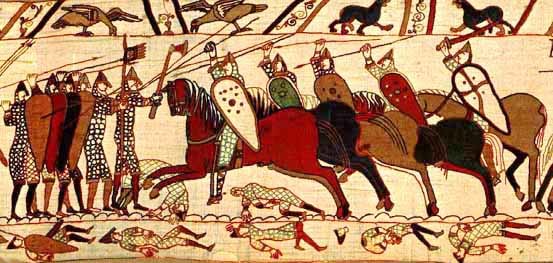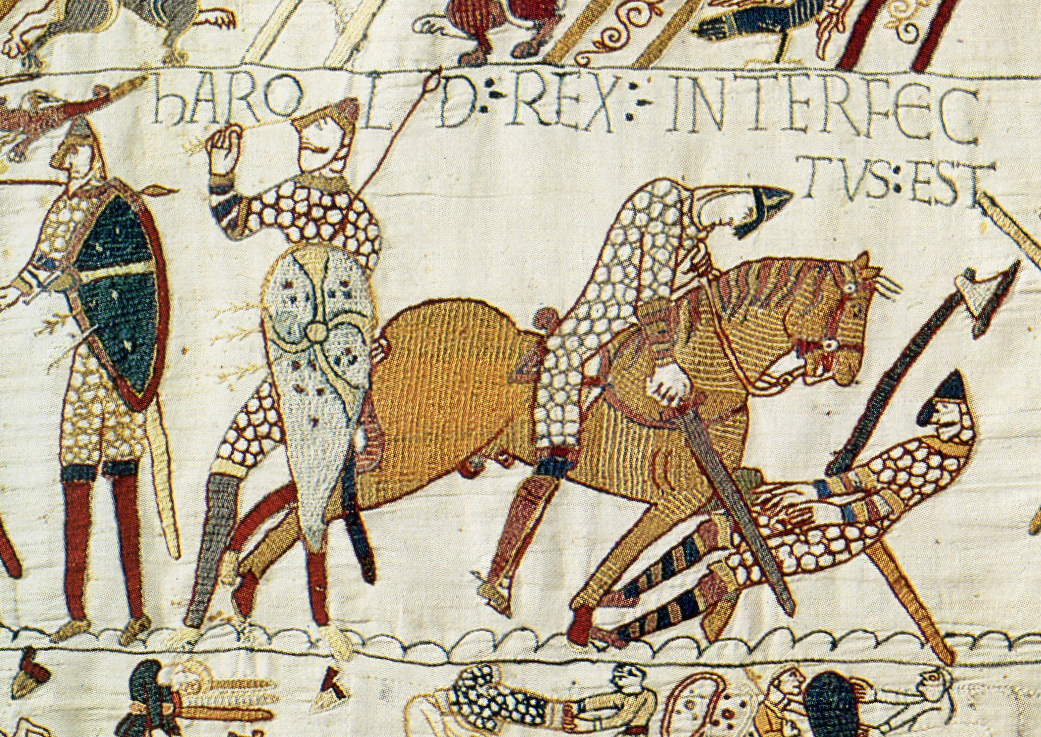 |
| Norman Cavalry Charges the Anglo-Saxon Shield Wall. |
The medieval Normans were the inhabitants of Normandy, an area in the north part of France settled by Viking invaders in the 10th century. They quickly acculturated to Christianity and to the Old French language. Along with other peoples of Northern France, in the 11th century they developed a powerful new combination of arms, armor and social structure. Their mounted knights became a superior force on the battle-field, and Normans became mercenaries, conquerors and lords all over the North Atlantic and the Mediterranean -- wherever they could find an opportunity.
A New Kind of Noble
Following the historian Robert Bartlet's interpretation, in the late 10th and early 11th centuries, the nobility in what is now northern France developed powerful new technologies and techniques. A knightly class of warriors developed out of older Germanic retainers and nobles. As heavily armored cavalry, the Frankish knight proved superior to older shield-wall infantry.
Knights required extensive lands to support their expensive armor and weaponry, horses and support personnel (squires). As a result, knights became a social elite.
Agriculture became concentrated on large manorial estates. Latin Christianity provided ideology and support.
Norman keeps (and later castles) leveraged military power.
Nearly indestructible without specialized equipment, the keep permitted a small force to raid and threaten or defend a large territory.
Frankish names, customs and technology spread widely. Words related to the new technology derive from Norman French terms:
Old French names became common throughout European nobility:
- Baldwin
- Charles
- Guy
- Henry
- Louis
- Richard
- Robert
- William
The Normans (and similar French and other warriors) quickly exported their style of rule and warfare. The Byzantines always had a market for mercenaries, and northern French warriors were active in many 11th and 12th century Byzantine wars. Things rarely worked out as the Byzantines would have wished, and the Normans carved out states of their own from Byzantine spheres of influence.
The Kingdom of Sicily is perhaps the best example. “Sicily” in the Middle Ages referred both to the island itself and to southern Italy in general. In the early 11th century, it had two main populations: Lombards, who owed nominal allegiance to the Byzantine Empire, held southern Italy, and, Muslims, who controlled the island. The Lombards hired the Normans (Northern French knights) to fight the Muslims in local wars.The Normans ended up consolidating S. Italy into the “Kingdom of the Two Sicilies.”
The Conquest of England
- Harold II, an Anglo-Saxon
- William, Duke of Normandy
- Harald, King of Norway
William emerged the ultimate winner. Norman nobility supplanted the Anglo-Saxon nobility and their language, culture and technology would greatly influence future England.
The Anglo-Normans (the nobility after the conquest) waged further campaigns of conquest in the British Isles. They expanded into Wales, where their fortified castles helped suppress Welsh resistance. Welsh kings competed with the Normans a time before being defeated c. 1280 The Normans made expeditions into Ireland, capturing many of its northern territories. They also made inroads into Scotland.
The Crusades
 In 1071, the Seljuk Turks defeated the Byzantine army and over-ran much of Anatolia.
In 1071, the Seljuk Turks defeated the Byzantine army and over-ran much of Anatolia.
In the aftermath, the Byzantines lost the major source of population and wealth. The Byzantine Emperor sent a request to western Europe for help. He wanted more mercenaries, he got the first Crusade.
The near-Eastern coast this became a western colony.
Various Crusades followed, few very successful.
After the shock of the unexpected first Crusade, the weak Muslim powers of the region consolidated. They gradually conquered terry until by the early 13th century only remnants of the Kingdom of Jerusalem remained.
The new style of mounted warfare pioneered by the Normans and the social structure it supported was beginning to lose its military dominance.
The Anglo-Normans (the nobility after the conquest) waged further campaigns of conquest in the British Isles. They expanded into Wales, where their fortified castles helped suppress Welsh resistance. Welsh kings competed with the Normans a time before being defeated c. 1280 The Normans made expeditions into Ireland, capturing many of its northern territories. They also made inroads into Scotland.
The Crusades
 In 1071, the Seljuk Turks defeated the Byzantine army and over-ran much of Anatolia.
In 1071, the Seljuk Turks defeated the Byzantine army and over-ran much of Anatolia.In the aftermath, the Byzantines lost the major source of population and wealth. The Byzantine Emperor sent a request to western Europe for help. He wanted more mercenaries, he got the first Crusade.
In western Europe, Pope Urban II circulated a call for war to drive the Turks from the Holy Land, because Muslims had harassed Christian pilgrims. Nobles and peasants alike “took the cross” and set out to war.
“God Wills It!” became their war-cry, and many stopped to kill Jews on their way to the rally points.
“God Wills It!” became their war-cry, and many stopped to kill Jews on their way to the rally points.
Their huge western Army crossed hastily through Byzantine territory, before conquering Jerusalem and surrounding areas. The westerners who remained set up Norman-style kingdoms around Jerusalem and other important cities. In these Crusader States, different populations co-existed uneasily:
- Western (Latin) Christians
- Eastern Christians
- Muslims
- Jews
The near-Eastern coast this became a western colony.
Various Crusades followed, few very successful.
After the shock of the unexpected first Crusade, the weak Muslim powers of the region consolidated. They gradually conquered terry until by the early 13th century only remnants of the Kingdom of Jerusalem remained.
The new style of mounted warfare pioneered by the Normans and the social structure it supported was beginning to lose its military dominance.


















